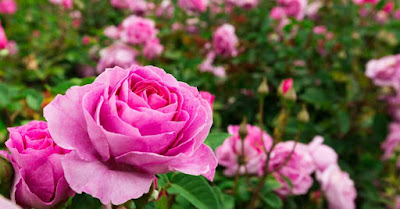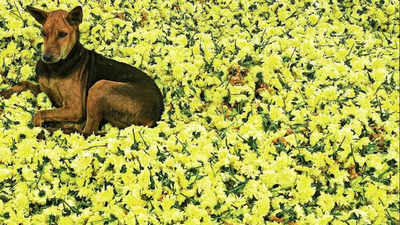Start with B - 28 Flowers Names and Types with Pictures
28 Flowers Names and Types with Pictures
Start with B
Baby’s Breath
Gypsophila is also referred to as Baby’s Breath. These plants are hardy annuals that are commonly used in cut flower arrangements.
The flowers are most commonly white but also come in pink or rose colors. The plant comes in dwarf varieties as well as tall plants that get up to two feet tall and wide.
Bachelor’s Button
The plant known as the Bachelor’s Button also goes by other names such as cornflower and Centaurea. It is a hardy annual that most people find easy to grow.
The plant comes in colors from white to red, and by practicing dead heading the flowers, you can prolong the flowering period of this plant.
Balloon Flower
The Balloon Flower also goes by the name Platycodon or the Chinese bellflower. This plant is an herb and perennial with a short flowering period.
The flowers are typically a shade of blue or white or pale pink. These spread slowly and tend to be compact, so you’ll want to mark their position to avoid removing them as a weed.
Ballota
Ballota is a sub-shrub that is evergreen and forms mounds. It can grow and spread 1 to 2 feet in height and width.
The rounded leaves are covered in a silvery wool-like substance, and they produce small white flowers that have a pink tinge to them. The flower through spring and summer.
Bee Balm
Bee Balm is a bergamot plant that comes as a hardy perennial. Also known as wild bergamot, the species is Monarda didyma.
While the flowers don’t store well when picked, the leaves can be picked and processed for medicinal and culinary uses, such as adding it to summer drinks or making a tea from the leaves.
Begonia
The Begonia is a showy flower with fleshy leaves that are green or bronze in color. The flowers come in many colors, and they are considered half-hardy annuals.
They come in a variety of sizes, from small flowers with fibrous roots to trailing flowers that do well in hanging baskets.
Bellflower
The Bellflower or campanula is a group containing several hundred species of annuals and perennials. These plants tend to be easy to grow with either full sunlight or dappled shade.
They range in height from a few inches off of the ground to over 5 feet tall and needing to be staked. They flower from May through September.
Bergamot
Bergamot is a relatively of mint plants and has a rather pungent and citrus-like flavor. This plant can reach several feet tall and comes in perennial and annual varieties.
The flowers may be white, red, purple, or pink, and the plant tends to be semi-dormant during the winter months. It likes a sunny area although will tolerate partial shade.
Bergenia
Bergenia is also referred to as elephant’s ears. These plants are a great evergreen ground cover and have large, rounded leaves.
Some of the leaves, while green throughout much of the year, turn reddish in the fall. The plant has small pink flowers and is hardy but should be protected during freezing spells.
Billbergia
Billbergia is an easily grown bromeliad, and they are often grown as houseplants. The leaves are stiff and the foliage is spiny and sometimes mottled.
The flower spikes often droop, with pink or red bracts that have green or blue flower petals. The most common species is known as Queen’s Tears.
Black-eyed Susan
The Black-eyed Susan is a type of coneflower that also goes by the name Rudbeckia. These plants are similar to daisies but have bright yellow-orange flowers with a black center.
These plants range in height, with some flowers able to reach eight feet tall, while they spread to a mere three feet.
Blanket Flower
The Blanket Flower belongs to the Gaillardia family of flowers. These plants have a long blooming season, from summer until fall.
They attract pollinators such as butterflies and come in a range of colors including reds and oranges. The flowers may be solid colored or a combination of colors such as red and yellow.
Blazing Star
The Blazing Star plant is native to the American prairie. These plants add a splash of color with their lovely spikes that come in shades such as blue-purple.
The plant blooms from the top down the flower stalk, and it is a popular choice for cut flowers. It also attracts pollinators such as hummingbirds and butterflies.
Bleeding Heart
The Bleeding Heart or Dicentra spectabilis is a plant with fern-like foliage and a unique heart-shaped flower.
The flowers tend to be pink and white, although some are pure white, and they are classified as a perennial. This plant grows best in filtered sunlight rather than direct, and it should be sheltered from drying, hot winds.
Bletilla
Bletilla is also referred to as the Chinese ground orchid. It is part of a small group of orchids from China and Taiwan, and it is typically easy to cultivate, unlike some orchids.
The flowers have a bell shape and may be purple to magenta in color. The tip of the flower has a characteristic coloring of white and cerise. The plant can also be found in a white form.
Bluestar Flower
The Bluestar Flower is a perennial native to the United States. It produces dense clusters of pale blue flowers during the spring, and the foliage in the fall turns a golden color.
The leaves are lance-shaped and whorl up the stem, while the cluster of flowers is produced at the top of each stem.
Bluebonnets
Bluebonnets or Texas Bluebonnets, as many of them are, belong to the category of Lupins. These plants are annuals that produce a blue to purple flower.
The plants as well as the seeds are highly toxic. These plants tend to thrive in soils that are prone to droughts and disruptions, such as found in Texas Hill Country.
Blue-eyed Grass
The Blue-eyed Grasses belong to the genus Sisyrinchium. These plants have spires of yellow flowers that bloom during the summer.
The leaves are strap-shaped foliage, much like those seen with irises. Some plants in this genus have blue or white flowers. These plants need full sun to grow rather than shaded areas.
Borage
Borage is an annual or biennial and can grow several feet tall. The plant has star-shaped flowers with a characteristic appearance from their protruding black anthers.
They come in sky-blue, white, and pink colors, and the bush features fragile branches that break easily because they are hollow. The stems and leaves are covered in fine hairs.
Bottlebrush
The Bottlebrush flower or Callisetemon earned its name because the flower looks very similar to a bottle cleaning brush.
There are several species of this flower, with color choices such as creamy yellow flowers to a rich matte red. Some are lemon scented, and all can grow up to seven feet.
Bouvardia
The Bouvardia plants are a genus of plants that belong to the Rubiaceae family. There are close to 50 species of these plants, which are largely native to Mexico and Central America.
The genus was named in honor of the physician to Louis XIII, Charles Bouvard. These flowering plants make great additions to cut flower arrangements.
Brachyscome
Brachyscome is also known as the Swan River Daisy. These plants do well in beds, containers, and even hanging baskets.
The leaves tend to be delicate and feathery, while the flowers may be single colors or mixtures. The flowers tend to be faintly scented but are not suitable to use as cut flowers.
Brassica
Did you know that you can grow ornamental cabbages and kales? Belonging to the Brassica family, some of the edible varieties come in colorful patterns, such as having pink, rose, or white leaves. While they can be damaged by a harsh frost, these plants tend to be better in cooler temperatures.
Broom
Broom or Cytisus is a deciduous plant that develops whippy stems. The flowers grow in thickly clustered bunches with yellow colored flowers that are fragrant and called “pea flowers”.
The scent is reminiscent of pineapple, and the plant can be grown to entwine with objects to make a focal point in your garden.
Buttercup
Buttercups belong to the genus Ranunculus. Some of these flowers are highly invasive, while other species are less so.
The genus has annuals and perennials, and many feature the characteristic yellow flower that we picture upon hearing “buttercups,” but some are cream or red in color. These are hardy plants that tolerate a range of conditions.
Butterfly Bush
There are three distinct species of butterfly bushes, with the most common as the deciduous Buddlejadavidii. This plant features cone-shaped flowers in colors such as white or purple-red.
Other species have a waterfall of shoots with purple flowers or feature small clusters of orange balls on the evergreen plant. They typically need full sun.
1) Start with A - 16 Flowers Names and Types with Pictures
2) Start with B - 28 Flowers Names and Types with Pictures
Powered by:
@AnandDewangan

































Comments
Post a Comment
If you have any doubts, Please let me know